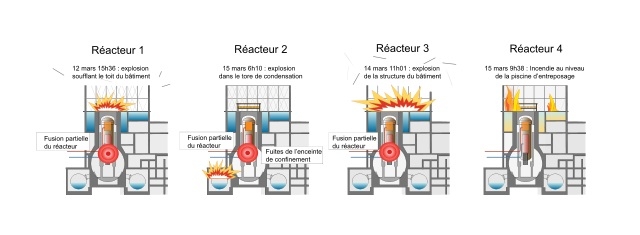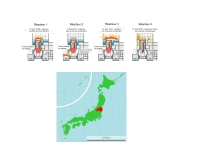Technology
FUKUSHIMA IN JAPAN - EARTHQUAKE AND TSUNAMI TRIGGERED THE WORST NUCLEAR ACCIDENT
TREMENDOUS DAMAGE TO NORTHERN OF JAPAN

(Source: Wikipedia)
Deadly radiation levels of up to 9.4 Sieverts per hour have been recorded at the Fukushima Daiichi nuclear power plant ““ enough to kill a person in less than an hour if directly exposed, local media reports. The mortal radiation reading was taken in a small room, using a remote-controlled robot, where a pipe leads to the containment vessel of the No. 2 reactor at the Fukushima No. 1 nuclear power plant, JIJI Press reported, citing Tokyo Electric Power Co (TEPCO).
The reading of 9.4 sieverts (Sv) per hour was taken during the September 4-25 checks. According to the operator, the highest levels of contamination were measured on the floor. TEPCO did not offer any further details. The company will start the decontamination process that it hopes to complete by December. (RT)
Back in 2011, the Fukushima Daiichi nuclear power station located in the Pacific Ocean coast received huge damage by the earthquake and tsunami. The piping facility in the building, the facilities for the external power supply and backup power were destroyed.
Back in 2011, the Fukushima Daiichi nuclear power station located in the Pacific Ocean coast received huge damage by the earthquake and tsunami. The piping facility in the building, the facilities for the external power supply and backup power were destroyed.
The next day, the leakage of radioactive materials had been found in front of the main gate of the nuclear power plant. The steam was filled in the building by the core melt down caused by the dysfunction of the cooling system. Lots of radioactive materials were scattered in the environment thorough “vent“ to reduce the internal pressure and the hydroponic explosions of the nuclear reactors. According to the estimates by Asahi newspaper based on the data from TEPCO, the amount of radioactive materials released into the air were 770,000 tera Bq until beginning of Apr.11,2011, and still going on with high risk. It is said that this amount is about 20% of the Chernobyl accident. (Fukushima on the Globe)
The Japanese government had set 20 mSv per year as a standard value of public dose limit for radiation exposure in Fukushima and used the figure for specifying the evacuation zone. The government conveyed messages that there would be no harm by the effective dose less than 20 mSv per year. According to their calculation of indoor radiation exposure as 40% of that of outdoor, the government set the safe standard level as 3.8μSv / h based on the estimated annual dose. Also, in the government publications such as supplementary reading materials distributed in schools, the government mentioned that there is no clear evidence for the risk leading directly to the cancer by exposure of radiation less than 100 mSv per year. (Fukushima on the Globe)
When the Chernobyl accident occurred, the reference value of forced migration was more than 5 mSv per year in addition to the level of soil contamination. Many epidemiological studies pointed out that there is a possibility that cancer and other diseases also occur in low-dose radiation even it is less than 100 mSv per year.
Earlier this week, a government commissioned study, said that nearly 40 percent of those involved in the emergency assistance operation at the Fukushima plant in March 2011 suffered radiation exposure exceeding the yearly public norm.
Ruby BIRD
http://www.portfolio.uspa24.com/
Yasmina BEDDOU
http://www.yasmina-beddou.uspa24.com/
Earlier this week, a government commissioned study, said that nearly 40 percent of those involved in the emergency assistance operation at the Fukushima plant in March 2011 suffered radiation exposure exceeding the yearly public norm.
Ruby BIRD
http://www.portfolio.uspa24.com/
Yasmina BEDDOU
http://www.yasmina-beddou.uspa24.com/
Ruby Bird Yasmina Beddou Eathquake Fukushima Japan Tsunami Nuclear Accident Magnitude Damage Miyagi Iwate Power Supply Facility Reactor Pressure Damage Chernobyl
Liability for this article lies with the author, who also holds the copyright. Editorial content from USPA may be quoted on other websites as long as the quote comprises no more than 5% of the entire text, is marked as such and the source is named (via hyperlink).






